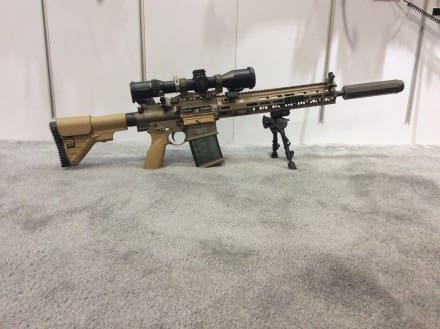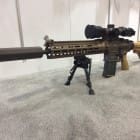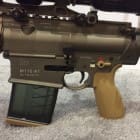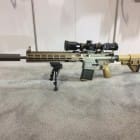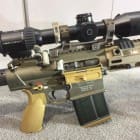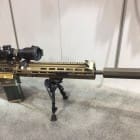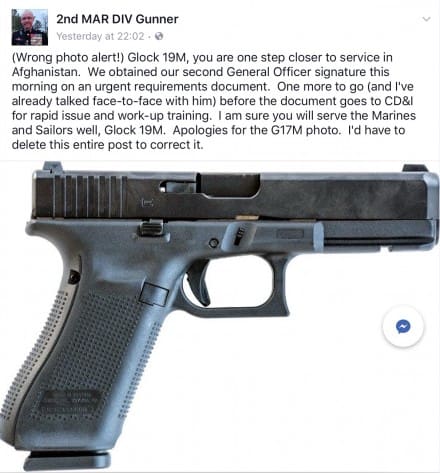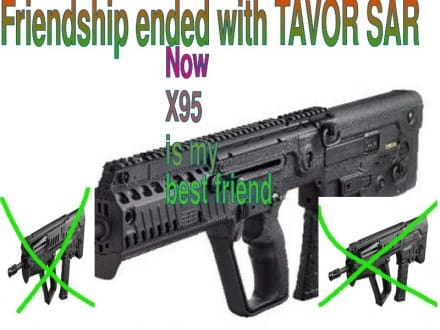 In an October 3rd Army News Service article, BG Brian Cummings, who serves as Program Executive Officer Soldier, discusses the Army’s on-again-off-again efforts to identify and field a 7.62 rifle capability.
In an October 3rd Army News Service article, BG Brian Cummings, who serves as Program Executive Officer Soldier, discusses the Army’s on-again-off-again efforts to identify and field a 7.62 rifle capability.
Reading the extract below, it seems that wires have been crossed somewhere. BG Cummings makes it sound like the Interim Combat Service Rifle effort is still underway. However, we, and others, reported several weeks ago it had been cancelled. Additionally, Deputy Director of the Lethality Branch at the Army’s Maneuver Center of Excellence Matt Walker (CSM, Ret), verified just last week, that they have ceased work on what he now describes as an “evaluation” despite it being issued as a solicitation.
As we posted on September 22nd, the M110A1 Compact Semi Auto Sniper System is still underway, although unfunded, and the directed requirement to field a Squad Designated Marksman variant of the H&K G28, also remains underway.
Without the ~50,000 ICSRs which would have been fielded, the Army will have to rely on the limited number of CSASS/SDMR procured in order to deal with the body armor threat Chief of Staff of the Army, GEN Mark Milley testified about in front of the Senate Armed Services Committee, earlier this year.
Below is the pertinent section of that Army News Service article.
STILL ON TARGET FOR NEW RIFLE
Despite some reports to the contrary, the Army is still looking for a new rifle that uses a 7.62mm cartridge.
“The chief [U.S. Army Chief of Staff Gen. Mark A. Milley] wanted an interim combat rifle, or he was only going to fulfill a requirement to have a squad-designated marksman in each squad, called a squad-designated marksman rifle,” Cummings said. “So, there are two efforts going on to get a 7.62 inside the squad.”
What are those two efforts? Cummings said that course of action No. 1 is to have one Soldier in a squad carrying the Squad-Designated Marksman Rifle, or SDMR. Course of action No. 2, he said, is to have multiple Soldiers in a squad with the Interim Combat Service Rifle, or ICSR. Both are 7.62mm weapons.
The SDMR is already a program of record for the Army, Cummings said, and there is a weapon already identified to fill that role: the M110A1 Compact Semi-Automatic Sniper System, or CSASS. That weapon is undergoing testing now, Cumming said.
But the ICSR and the SDMR do not represent the future for what weapons will be issued to most Soldiers.
“Right now, many are focused on the ICSR or SDMR,” Cummings said. “But that’s not the long-term way ahead. The long-term way ahead is a brand new rifle for all of the Department of Defense called the Next Generation Squad Weapon.”
The Next Generation Squad Weapon, or NGSW, is actually two weapons, he said. It will include one rifle to replace the M249 Squad Automatic Weapon, and then a carbine that replaces the M4. Both the M249 and the M4 use the 5.56mm cartridge. The NGSW will likely use a different caliber cartridge than 5.56mm.
“For the next-generation, we wanted to make one end-all solution,” Cummings said. “With the M4, when you look at it, it’s got all these things hanging on top of it. We keep evolving by putting on things. The next-generation is going to be kind of like what we did with the pistol, with the modular handgun system. It’ll be one complete system, with weapon, magazine, ammo and fire control on it and we will cut down on the load and integration issues associated with it.”
The general said the U.S. Marine Corps is “on board” with development of the NGSW, and the British are interested as well.
Cummings said the Army can expect to start seeing the Next Generation Squad Weapon by 2022, in about five years. That will include the weapon, magazine and bullet. Later, by 2025, he said, Soldiers can expect to see a fully-developed fire-control system.
Until then, Cummings said, the Army is working on an interim solution to get a larger-caliber rifle into the hands of at least some Soldiers. It’ll either be the SDMR in the hands of one Soldier, or the ICSR in the hands of some Soldiers. But, he said, “the final decision has not been made.”


